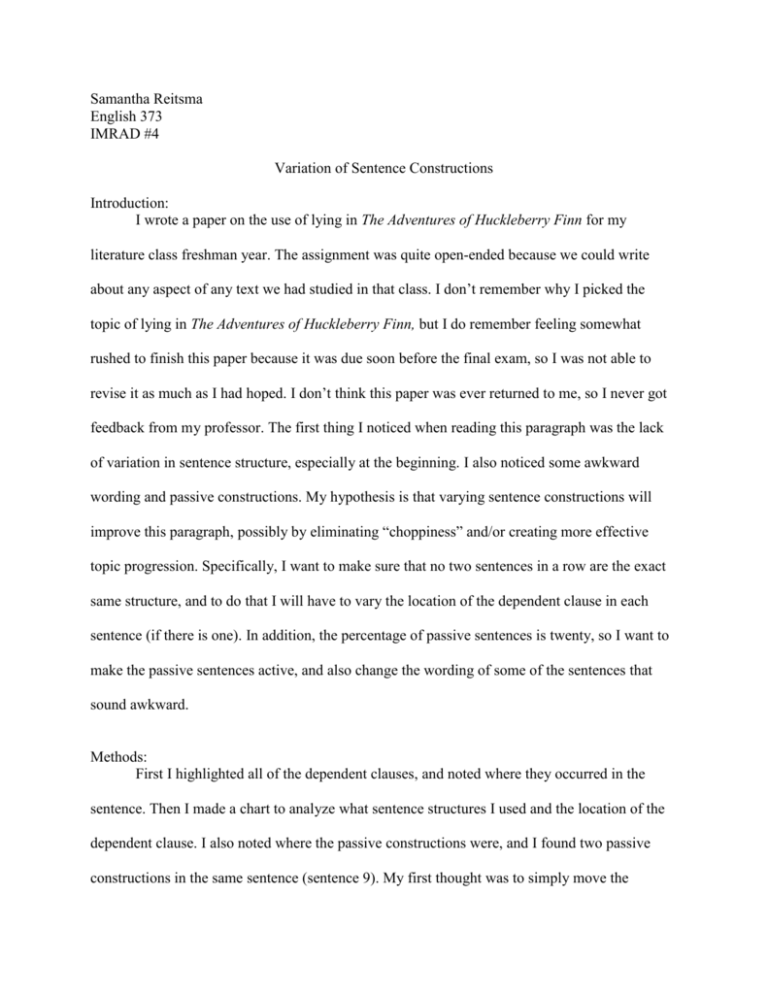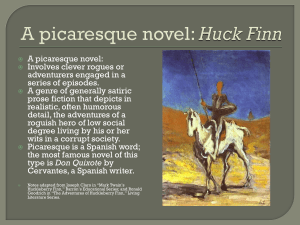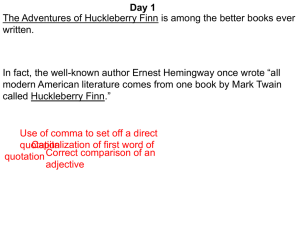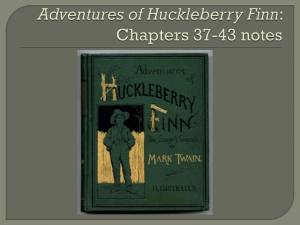imrad4 - WordPress.com
advertisement

Samantha Reitsma English 373 IMRAD #4 Variation of Sentence Constructions Introduction: I wrote a paper on the use of lying in The Adventures of Huckleberry Finn for my literature class freshman year. The assignment was quite open-ended because we could write about any aspect of any text we had studied in that class. I don’t remember why I picked the topic of lying in The Adventures of Huckleberry Finn, but I do remember feeling somewhat rushed to finish this paper because it was due soon before the final exam, so I was not able to revise it as much as I had hoped. I don’t think this paper was ever returned to me, so I never got feedback from my professor. The first thing I noticed when reading this paragraph was the lack of variation in sentence structure, especially at the beginning. I also noticed some awkward wording and passive constructions. My hypothesis is that varying sentence constructions will improve this paragraph, possibly by eliminating “choppiness” and/or creating more effective topic progression. Specifically, I want to make sure that no two sentences in a row are the exact same structure, and to do that I will have to vary the location of the dependent clause in each sentence (if there is one). In addition, the percentage of passive sentences is twenty, so I want to make the passive sentences active, and also change the wording of some of the sentences that sound awkward. Methods: First I highlighted all of the dependent clauses, and noted where they occurred in the sentence. Then I made a chart to analyze what sentence structures I used and the location of the dependent clause. I also noted where the passive constructions were, and I found two passive constructions in the same sentence (sentence 9). My first thought was to simply move the dependent clause from the beginning of sentence 2 to the end, so it would not be similar to sentence 3, but doing that made it a simple sentence and therefore too similar to sentence 1. I realized this process would be more challenging than I had previously thought; it was like solving a giant puzzle. After editing the paragraph, I included the new results in italics. Results: Sentence # Sentence structure 1 2 3 4 5 Simple (no change) Complex (no change) Complex (no change) Complex (compound) Simple (eliminated/incorporated into sentence 2) Compound-complex (compound and less wordy) simple complex Compound (changed passive to active) simple 6 7 8 9 10 Location of Dependent Clause beginning Beginning (end) Beginning (no dependent) Beginning (no dependent) end Original Paragraph: One way that Huck lied was through assuming a false identity. Throughout the story, he used eleven different aliases. With his first alias, Sarah Mary Williams, he pretended that he was on his way to tell his uncle that his mom was sick. His second alias, George Peters, he formed on the spot when he realized he was caught in a lie. Four different times Huck assumed the nameless role of a boy in distress. When Huck boarded the raft to find out information, he assumed the identity of Charles William Albright, a character in a ghost story he had just heard, but later assumed the more believable identity of Alec James Hopkins to convince the raftsmen that he just wanted a ride. Huck also used the alias of George Jackson to protect his own identity. Sometimes, however, Huck had to use aliases to protect Jim, such as when Huck pretended that his dad and little brother drowned and Jim was his property. In other instances Huck did not pick his alias; one time he was given an alias by the king, and another time he was thought to be Tom Sawyer. Huck had to come up with most of these aliases on the spot to protect himself and his friend Jim. Edited Paragraph: One way that Huck lied was through assuming a false identity. Throughout the story, he used eleven different aliases, four of which were the nameless role of a boy in distress. He used his first specific alias, Sarah Mary Williams, while pretending he was on his way to tell his uncle that his mom was sick. His second alias was George Peters; he formed this alias on the spot because he was caught in a lie. Another specific identity Huck assumed was Charles William Albright, a character in a ghost story he had just heard, but he later assumed the more believable identity of Alec James Hopkins to persuade the raftsmen for a ride. Huck also used the alias of George Jackson to protect his own identity. Sometimes, however, Huck had to use aliases to protect Jim, such as when Huck pretended that his dad and little brother drowned and Jim was his property. In other instances Huck did not pick his alias; one time the king gave him an alias, and another time someone thought he was Tom Sawyer. Huck had to come up with most of these aliases on the spot to protect himself and his friend Jim. My initial impression, that there was lack of variation at the beginning of this paragraph, was confirmed with the occurrence of three complex sentences in a row. Sentence 2 and sentence 3 had an identical structure, with the dependent clause at the beginning. Sentences 3 and 4 were similar because they both contained an appositive phrase at the beginning, but at least sentence 4 began with an independent clause. However, I did not like the wording of sentence 4. I changed this sentence so that the awkward pause created by the comma before “he” became a semicolon. Fortunately, I only had to change a few of the sentence structures or move a few dependent clauses so that no two consecutive sentences were alike. I also decided to move sentence 5. This short sentence was not expanded on later, but because the thought was introduced, the reader might think that the next sentence will be about a specific “boy in distress” alias. To correct this misconception, I first added the transition phrase, “Another specific identity Huck assumed…” to the beginning of sentence 6 to remind the reader that I am continuing off from the last alias and am only describing specific aliases. Then I incorporated sentence 5 into sentence 2, so it would not seem like an interruption of the specific alias examples. Lastly, I added agents of action to sentence 9 to make it active voice. Discussion: Varying the sentence constructions was not as noticeable of a change as changing awkward wording or passive voice to active, but a few “bonuses” resulted from changing the sentence constructions. For example, I noticed that after I revised this paragraph, there was good topic progression (hypertopic progression, I believe) between sentence 2 and 3. “He used eleven different aliases” transitioned well into “he used his first specific alias.” Also, when I added the transition, “Another specific identity Huck assumed,” it continued the theme of parallel progression, where Huck is mentioned at the beginning of each sentence, along with a transition word before the alias (first, second, another, also, etc.). I added this transition before I moved sentence 5, but when I took sentence 5 out from its original place, I realized that this transition fit well with the beginnings of the rest of the sentences, and allowed the reader to transition easily from the previous alias. Another benefit from varying sentence structure was the variation in the length of sentences. Instead of having two simple sentences in a row, creating a “choppy” feeling, I tried to make it so a short sentence followed a long sentence, and vice versa. I think the most effective changes involved changing the wording. One example was incorporating sentence 5 into sentence 2. Because I did not have much time to revise this paper, I didn’t realize until now how out of place that sentence felt. Also, I didn’t realize how long and wordy the compound-complex sentence was; when I made it less wordy the sentence structure changed to compound. It was also effective to change the two passive constructions in the same sentence to active voice, and as a result, wordiness improved. “He was thought to be” became “someone thought,” and “he was given an alias by the king” became “the king gave him an alias.”







